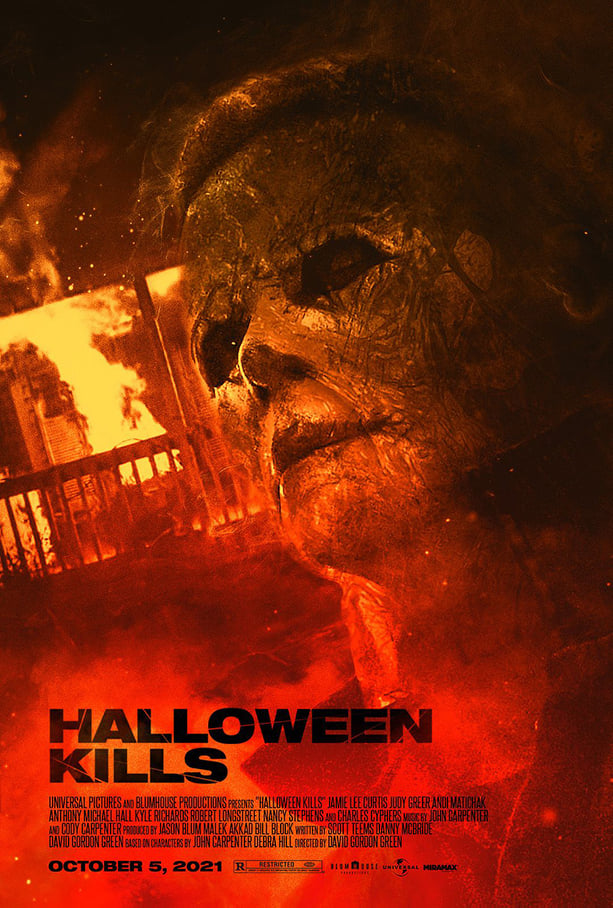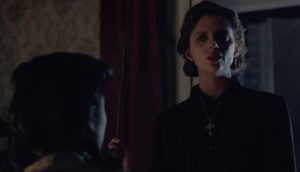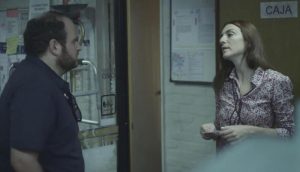A mob chant becomes prominent at one point in the new film, Halloween Kills.
Haddonfield residents, having put up with the memories and fallout of Michael Myers’ rampage 40 years ago, as well as the “current” evening’s events, are taking the law into their own hands. And so, led by a now-grown Tommy Wallace (Anthony Michael Hall) an angry mob bursts into shouts of “Evil dies tonight! Evil dies tonight!”
Given that this film fails on practically every level imaginable, it’s an easy change of phrasing to offer this, “This franchise dies tonight!”
Taking a cue from the original film’s sequel (1981’s Halloween 2), and picking up directly following the events of the original (in this case, 2018’s Halloween), Halloween Kills finds Laurie Strode (Jamie Lee Curtis), her daughter Karen (Judy Greer) and granddaughter Allyson (Andi Matichak) riding away from what they believe is the last they’ll ever see of Michael Myers, “dead” in a devastating house-fire. But we all know that you can’t keep a good Michael Myers down, and so the chaos of the previous installment continues on this Halloween of 2018.
I rewatched (only my second viewing) the 2018 installment, just prior to taking in Halloween Kills. And damn, it still works. Check out my review on that film here. It was exciting, emotional and felt like it belonged, a valuable part of the franchise and of the Myers legend.
Halloween Kills? Not so much. This installment is ranking somewhere down in the dumps, like on the level of Halloween: Resurrection terrible. Truly, it is that bad.

The central problem here, is that we’re given little to no insights into Laurie’s continued journey. There is no driving force for us as an audience, to root for. Curtis has all of perhaps 15 minutes of screen time, and the rest is given to supporting characters – namely Laurie’s former wards, Tommy and Lindsey (Kyle Richards). Why, Curtis doesn’t even appear until a good 20 minutes into the film. Instead, we’re made to wade through an ultimately pointless and clunky flashback and then an overly long bar scene, introducing several characters from the 1978 classic.
In that aforementioned flashback, we see how Sheriff Hawkins (Will Patton) was involved in the Myers 1978 murder-escapade and how it had a lasting negative effect on his life. Granted, this subplot comes back around, but immediately I wondered, why do I care?
Also, the non-sensical intro of Lonnie as part of the “Myers’ Survivor Gang” is odd. He was a bully in the 1978 film, and the tacked-on run-in with Myers back in ‘78 doesn’t work. And on that note, how/why would Nurse Marion have developed a relationship with Lindsay Wallace and Tommy Doyle? It is possible? Yes. But likely? No.
Bottom line: I’m here for Laurie Strode. Yes, we love Michael Myers, but I’m a character guy. I want to see what Laurie’s doing. The previous installment brilliantly introduced us to her estranged family, her legitimate PTSD and how one-minded her life has been for the last 40 years. If that’s not character baggage an audience can latch onto – building immediate sympathy – then nothing is.
Giving Laurie so little screen time and frankly, nothing to do – is the big issue here.
How much time did we spend with one-off characters (sometimes two-off)? The old couple who lived down the road from Laurie’s compound. Why should I care? The gay couple (despite my adoration of Michael McDonald) living in the beautifully-remodeled Myers’ house. Why should I care?
And to throw more fuel on the fire of my disappointment for this film – you introduce characters from the past, in some cases played by the same actors – and then systematically and unceremoniously kill them. I’m looking at you, Nancy Stephens as Nurse Marion. Or Sheriff Brackett (bringing Charles Cyphers back into the mix). I apologize for the blatant spoilers, but…why? What’s the point? Letting us into the lives of characters we’ve loved or admired for decades, only to slice and dice them with no sadness or reverence?
I’m reminded of another such slight in a previous installment of the Halloween franchise: Halloween 5: The Revenge of Michael Myers. We’re made to love Rachel Carruthers in Halloween 4: The Return of Michael Myers: her spunk, her resourcefulness and her love for little Jamie, only to see her killed in the first few minutes of that 1989 release. These are poor writing choices, and simply lazy.
But again, it all comes down to this: Where’s Laurie? That’s who we care about. And by association, her daughter and granddaughter. It bears pointing out that even though these are our main characters, I didn’t give a lick about their well-being. And that, my friends – is a giant fail – certainly for Laurie, whom horror fans have loved for over 40 years. If audiences can’t love friggin’ Laurie Strode – and it’s a built-in love – then man – you filmmakers have really failed.
Even Carpenter’s score this round, was not on the mark. 2018’s score was a genius mix of all that we wanted as fans, with new additions and takes on the themes we adore. Namely, that music cue when Michael begins his big chase of Allyson… lovely and jarring. But here, there’s a great deal of melodramatic piano, giving an unwelcome and odd taste of “soap opera”.
And there was a prominent lack of plausibility around every corner. I often find it distracting if something comes up, which in real life (and this is a “real” story, basically taking place in the real world) would not happen. A morgue with windows? On the main floor? Naked corpses available to observe, right off the hospital’s main waiting room? Or Karen risking life and limb to help some random mental patient? I know she’s a shrink, but weren’t there other more pressing things to handle, like “Where’s my daughter?” or “My husband just died” or “My mother’s in an ICU”. I mean, c’mon…
Acting was also quite a problem. Even seasoned veterans like Curtis couldn’t wade through this terrible storytelling and eye-rollingly bad dialogue. But of all the performances, none were as painful as what Anthony Michael Hall brought to the proceedings. I bought nothing he was selling, and as excited as I was about his casting – his performance felt one-note and flat.
Overall, the film is best described as “filler”, but I frankly can’t recall an entire film of unimportant detours into the lives of other characters who don’t service the story, taking up this much of a movie’s run-time.
On a side, but related note: If you’re giving us a “Laurie Strode” story, then make it about Laurie Strode. If you want to make an off-shoot television series, entitled “The People of Haddonfield”, where each week, you take in the personal stories of Haddonfield residents, and how the Myers’ legacy has damaged them over the years, then do it. Heck, that’s a great idea. But don’t promise me a Strode story and give me 20 or so minutes of time with her. It’s just bad form.
I simply can’t understand how basically the same team from the film three years ago, was able to masterfully rejuvenate this franchise – with fun Easter eggs, giving us more time with beloved characters and offering a wonderful sense of nostalgia, hitting its mark right on – could then turn around and fumble so horribly. It’s truly mind-boggling how badly this film was botched.
I hate to be so bold in my proclamations, but this makes me terrified for Halloween Ends. Not because I know that Michael Myers will return (a la James Bond), but because this sophomore effort was such a dreadful film-going experience. Clearly, lightning does not strike twice.



